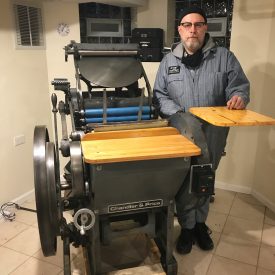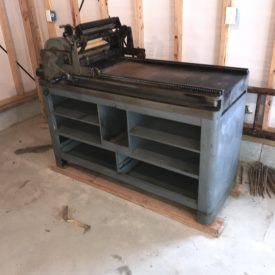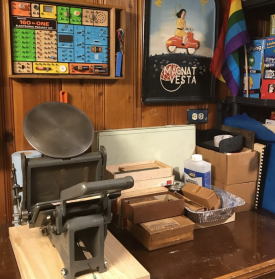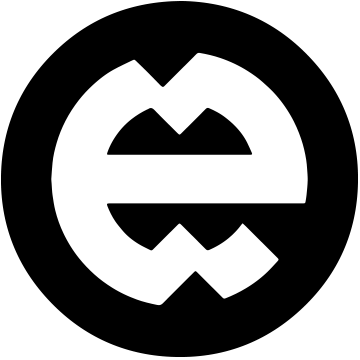Our Printing Presses

Our main press is a 10×15″ Chandler and Price “Model N” platen press made in Cleveland. Aside from a few minor improvements over the years, these presses didn’t change much from the 1880s until they were discontinued in 1964. Our press has a Zip code (introduced in 1963) listed on the nameplate, so we figure ours was among the last C&P presses made. We acquired it in early 2021 an auction from a retired printer in Morris, IL, who bought it a decade earlier from a printer in Maine.

We share space with C’mon Home, another printer, who generously allows us to use their 1948 Vandercook #3 cylinder press. These were traditionally used for proofing book and newspaper pages, but these days they’re mostly used for posters, album covers, and such… bigger sheets than the C&P can handle. This press was manufactured right here in Chicago, less than a mile from our shop! This model is entirely manually-powered, with cranks to ink the rollers and to roll the carriage over the print bed.

Last but not least… well, it is least of the three presses, in any quantifiable measure… is our 5×8″ Kelsey “Excelsior” tabletop platen press made in the 1950s in Connecticut. It’s also hand-powered and hand-fed, so it’s best for very small runs of business cards, tickets, postcards, and such.
Our Type
Here’s a catalog of the 60-ish metal/wood type fonts we have in the shop. Obviously, for hand typesetting, we’re limited to these, though if budget allows, we can find other fonts on the used market or from a few remaining metal and wood type foundries.
Remember that a “font,” in the traditional sense, is a specific size and style of a face (Caslon Old Style Italic 14pt), not the whole typeface family (Caslon). A letterpress printer can’t “bold” a word if we don’t have the same typeface in the same size in bold. And we’ve only got so many characters in each font. In large type sizes we may not have enough letters to compose more than a few words. We’ve also got a big collection of random vintage advertising cuts (logos, illustrations, headshots, catchwords, dingbats, and symbols).
Note that with polymer plates, we can use any digital typefaces or artwork.
Our Inks
Our stockpile of ink is at your disposal at no additional cost. Special-ordering or custom-mixing a color will add some cost and time, but any color is available.
Other Equipment
Of course, we’ve accumulated all the other odds and ends needed to set type and print: slug cutters, a type saw, paper cutter, ink scales, spacing, leading, quoins, reglets, furniture, galleys, guides, tympan paper, composing sticks, bodkins… you can never have enough bodkins.
Sustainability
We could greenwash you like most industries do, but we’re caring lefties, and wouldn’t want to be anything less than 100% straight about it: There’s plenty of good stuff to talk about, but a couple things that could be better…
- POWER: Our orthopedist will tell you that the Vandercook and Kelsey presses are entirely human-powered. The C&P press features a treadle for foot power, but it’s far more practical to use its 1/2hp motor. The press (and the rest of the shop) is powered by Chicago residential 120-volt electrical juice. For most jobs, the press is only running for an hour or two. We’re not using any more electricity than your television. And if there’s a blackout, we can crank up some Art Tatum on the Victrola and print by candlelight. (I’m not even joking.)
- EQUIPMENT: One of the coolest things about letterpress printing is keeping useful, well-built, old equipment off the scrap heap. Almost everything in our shop is between 50-100 years old, and is likely to be useful for another century or two. It’s all changed hands many times between businesses and hobbyists and if it breaks (or is mutilated by termites), it gets repaired, not thrown away. When we’re gone, we’ll pass all this gear along to the next sucker that wants to have a go at it. Countless innovations have come and gone in the industry in my lifetime. We’ve seen several generations of multimillion-dollar typesetting, design, and printing systems rendered obsolete, even useless within a couple years. It’s good to know this equipment was built to last and will be perfectly functional for another lifetime, at least. We’ll never have to install a Chandler and Price firmware update.
- INK: We use a variety of inks. Most new inks are vegetable/soy-oil based, though some colors (mostly metallics) use a small percentage of petroleum oil. Our huge stash of second-hand ink from the 1990s is petroleum-based, but using it is more ecologically responsible than throwing hundreds of pounds of perfectly good ink in a dumpster.

- PAPER: My dad’s family grew up in a paper town, and my grandpa worked at the mill most of his life. Back then, it was a very ugly, dirty business. Modern papermaking is much improved. We’ve visited several paper mills (that’s where we go while you’re at the beach) and have witnessed logging operations first-hand, so we can talk at great length about the paper industry. Industry PR paints things a bit rosier than it probably is, and internationally there are questionable practices, but from what we’ve seen first-hand, the domestic mills that make the papers we use are surprisingly ecologically sound. Wood is responsibly sourced, manufacturing is generally powered with green energy (all paper mills must be on a river, so many are hydroelectric powered). Some even create power for the local community. The chemicals they use are safe, and there’s surprisingly minimal waste. Turns out being efficient and ecological is also profitable. All paper is recyclable, of course, and recycled paper is available (though generally more expensive). We’re happy to talk about all this in more detail and make sure you’re comfortable with your paper choice.
- SUPPLY CHAIN: We get most of our paper, ink, and other supplies from small-ish distributors that cater specifically to our industry. Shipping is pollute-y (and expensive) so we do all we can to limit shipping and buy locally when we can. We use domestic suppliers, and avoid Amazon, Uline*, and other unsettlingly-large/powerful companies, which sometimes reduces our options and makes things slower and more expensive, but it’s worth it.
(*we would like to thank Uline for sending their huge catalogs, we use their supercalendered catalog paper for free, recycleable press packing!) - SHOP WASTE: We recycle leftover paper (often re-using trimmings for another job), metal, and plastic (through Chicago’s admittedly-kind-of-questionable system). We — as most printers do — throw damaged or scrap type/leading into a “hell box” which is returned to the typecaster to be melted down and re-used. Metal type is made of a lead alloy that is entirely safe if handled properly (but please don’t lick/eat our type). We clean the press with odorless mineral spirits and disposable shop rags. We do this in as safe, ecological, and minimal manner as possible (we’re down to 4 or 5 paper towels and a few squirts of spirits per press wash-up!) but we’re looking for a more sustainable cleaning system, both for the environment and for our own health and safety.
As we grow with your support, our larger scale will allow us the leverage and income to address these few remaining ecological concerns, we look forward to someday soon being in a green-powered space and being able to brag about our practices, but in the meantime, we’ll be honest about our challenges and goals.

You must be logged in to post a comment.